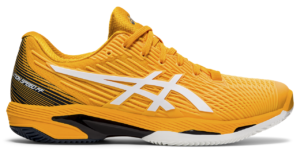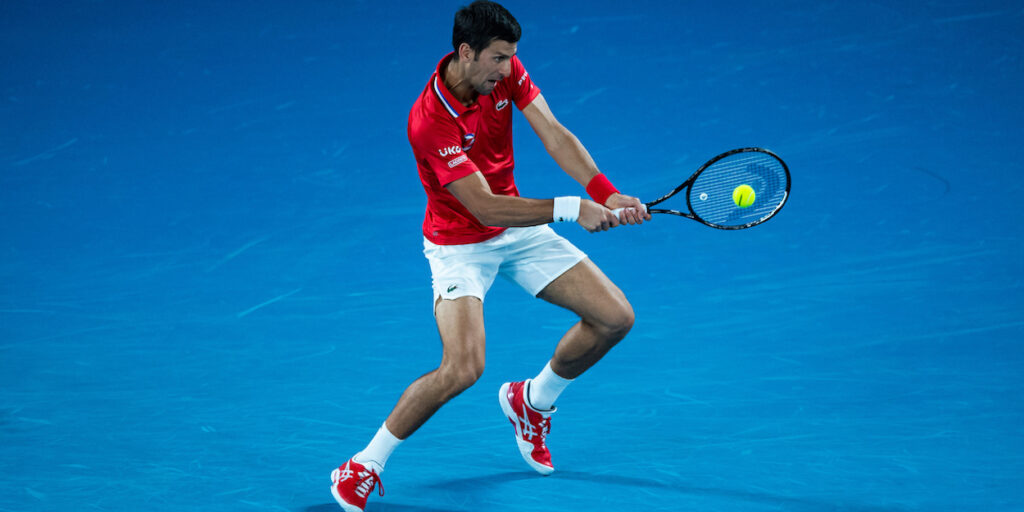
Exclusive interview with ASICS design expert: How to create the perfect tennis shoe
Rene Zandbergen is Head of Footwear Innovation, Tennis at ASICS Europe. Tennishead spoke to him about the different aspects that go into making a good tennis shoe
Tennishead: Why is it important to wear a specifically designed tennis shoe rather than wearing a running shoe or general cross training shoe when you play tennis?
Rene Zandbergen: If you look at a non-tennis shoe like a running shoe you will see that the sides are straight, rather than a tennis shoe which has more rounded sides. This is because runners aren’t changing direction. They are running in a straight line forwards nearly all the time. Tennis players have to move in all directions all the time.The roundness of the side of a tennis shoe is because the grip of the shoe wraps around the sides to provide support and stability when a tennis player is changing direction. Tennis players also require greater flexibility in the sole to provide comfort when they are changing direction.
TH: How have ASICS developed the tennis shoe?
RZ: ASICS now focus on providing a shoe that matches the playing style of the tennis player. After an intense period of research and validation with the tennis community, we came to the conclusion that it is extremely difficult to pick the right tennis shoe to support a players game. So we decided to make the decision process easier for everyone. We have identified three distinct styles of play in tennis and have focused our efforts on designing shoes to match each of these three styles.
The three styles are the baseline player, the all-court player and the ‘best of both’ player. Our Gel-Resolution shoe is designed for the baseline player, the Solution Speed is for the all-court player and the Court FF shoe is for a player who needs the best of both, this shoe we designed with Novak Djokovic.
We encourage tennis players to think about their own style of play and then to choose a shoe that is specifically designed to support that style. We ask all ASICS store staff to question the customer right at the start about their style of play to help make sure they choose a shoe that supports their natural playing style.
Then there is the question of outsole. Typically there are two widely used versions, and every shoe we offer comes in both – that is clay for the iconic red clay of the French Open, but also gravel – and there is hard court.
So you can first identify you’re playing style, then select the surface you typically play on and then you should have the perfect tennis shoe!

Headquartered in Kobe, Japan, ASICS is a leading designer, manufacturer and retailer of high-performance athletic footwear, apparel and accessories
TH: Can you give us a brief explanation of the background behind the original Solution Speed shoe?
RZ: ASICS introduced the Solution Speed shoe to cater for an all-court player. These are players that don’t play all their tennis from side to side, behind the baseline because they like to be more offensive and to move around the court and especially into the net.
The Solution Speed is our lightest shoe, designed to help this offensive player to move as fast as possible when they are attacking the net. We designed the Solution Speed to be more flexible to meet the demands of a dynamic – fast player, think Alex de Minaur.
TH: Can you explain why the shoe has been updated for the Solution Speed?
RZ: ASICS follow the ethos of ‘Kaizen’ which means ‘continuous improvement’. This is how we have developed the Solution Speed 2. There are three new technologies in this version of the shoe
Our patented Twisstruss technology has been extended to the front of the shoe. You will see in the previous Solution Speed that Twistruss was only placed in the midfoot of the shoe but now it extends all the way to the front. This is because our professional players like David Goffin told us that the key for them was to be able to move quicker around the court. By adding Twistruss to the front we can help to deliver a springboard of energy that catapults the player forward when they push off from their toes. David mentioned that it “Feels like a 1-second head start.”
Flytefoam already featured in the original Solution Speed but now we’ve added Flytefoam Propel into the mid sole which is a softer & lighter cushioning material. This has reduced the weight of the shoe, made it more comfortable and provides a higher energy return.
ASICS GRIP has been extended to the toe area of the shoe (the yellow section) for the Solution Speed 2. This again helps the player to move faster as they can have a greater grip on the court in the front of the sole which helps them to push off faster as they move to the ball or recover after a shot.

TH: Are the developments in the Solution Speed 2 based on new materials or new research
RZ: ASICS are unique in having our own Institute of Sports Science in Kobe in Japan. This is where we have tennis courts that we use to test and to record and monitor how tennis players move and these learnings are then applied when we design and manufacture a shoe.
The Solution Speed 2 features a combination of further developed materials and research into the way an all-court tennis player moves around a court.
We also spoke to players like David Goffin and Alex de Minaur to help us improve the original Solution Speed shoe.
TH: When ASICS are working closely with professional players, what comes first, the player or the shoe?
RZ: We speak regularly to all our players to get updates on how they feel about their shoes and if they can suggest changes.
For the Solution Speed, the shoe was already available before ASICS started talking to players like David Goffin and Alex de Minaur.
When David Goffin joined ASICS he started off wearing the Court FF shoe but we spoke to him about his style of play and encouraged him to try the Solution Speed – he has been using this shoe every since.
Interestingly Novak Djokovic started off at ASICS wearing the Gel-Resolution shoe. We had regular conversations with Novak and he told us he wanted more flexibility in the shoe to match the movement he makes on court. We decided the best action for us would be to design a shoe specifically for Novak to match his all court style of play. That is why we launched the Court FF Novak. This shoe is unique in that it is fit for the #1 player in the world, but we at ASICS have made that technology accessible to all. The shoe you pick up in-store is virtually the same as the one on the feet of Novak Djokovic.
TH: How much difference does it make having the correct sole of shoe for the court surface you are playing on?
RZ: Considerable difference, but that does depend on the level of the player. If you are a club player playing doubles once a week then the sole of the shoe will have less of impact and you can probably manage by using say a hard court sole on a clay court.
However once you start to play singles then the increased movement around the court means that you will see a much bigger difference by wearing the correct shoe sole for the surface you are playing on
A clay court sole is designed to help the clay move through the sole of the shoe rather than stick in the sole. This means that if you use a hard court sole on a clay court then the clay is likely to stick to the shoe and therefore reduce the grip considerably. This is especially the case in damp conditions.
TH: How often should an amateur tennis player change their shoes?
RZ: This is the most difficult question I’m ever asked because it really does depend on the circumstances. So if we focus on the signs to look out for on your shoe that is much easier to answer.
When you first buy a tennis shoe I think it’s a good idea to take a photo of the top and the sole of the shoe. This will really help you when you come to check the wear of the shoe.
Firstly, look for wrinkles in the midsole of the shoe. If you look at a new shoe then you will see there are no wrinkles but as shoes start to wear out then wrinkles will start to appear on the mid sole, just like human skin!
Secondly, look at the grip pattern on the sole of the shoe. Is the pattern disappearing?
Thirdly, you can look at the side of shoe around the fabric as this will start to wear out as the shoe is worn more and more.
The other factor that effects the longevity of a shoe is the temperature. For example, if you play tennis in a country like Spain it can reach up to 50 degrees on the court around your foot and this will impact the materials and make them wear out quicker than if you are playing in cooler conditions.
TH: What developments will we see in shoe technology over the coming years
RZ: I expect that ASICS will start to use our engineered materials in more areas of the shoe and more often. For example, we are looking at aways to make our stability elements like our twistruss more dynamic throughout the shoe.
View the full range of ASICS tennis shoes at ASICS.com
- Join the tennishead CLUB and receive £250/$350 of FREE GEAR including ASICS Gel-Resolution 8 trainers, shorts, shirt & socks
- Keep up to date with the breaking news & tennis action at our tennis news section
- Win amazing prizes by entering our competitions
- Learn more about your favourite players including Roger Federer, Rafa Nadal and Novak Djokovic
- Check out the latest tennis equipment with our tennis gear reviews
- Receive regular updates in our legendary free newsletter
- Read in depth features with stunning photography in tennishead magazine
- Can’t visit the tournaments you love? Check out our guide on how to watch tennis on TV
- Don’t miss a thing with our Live Scores service
- Follow tennishead on social media at Facebook, Twitter, Instagram & YouTube
- EXCLUSIVE 5% DISCOUNT for all tennishead readers on tennis rackets, balls, clothing, shoes & accessories with All Things Tennis, our dedicated tennis gear partner


